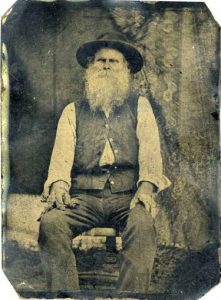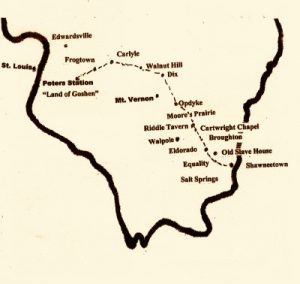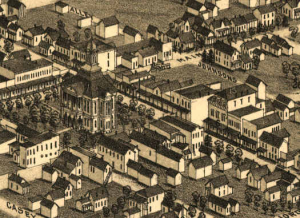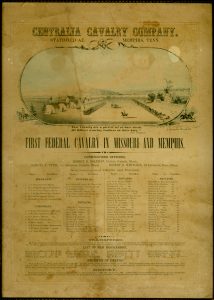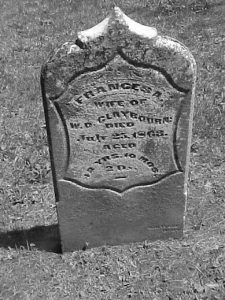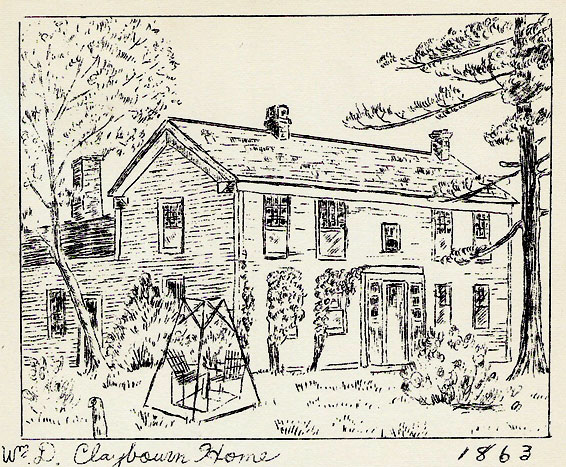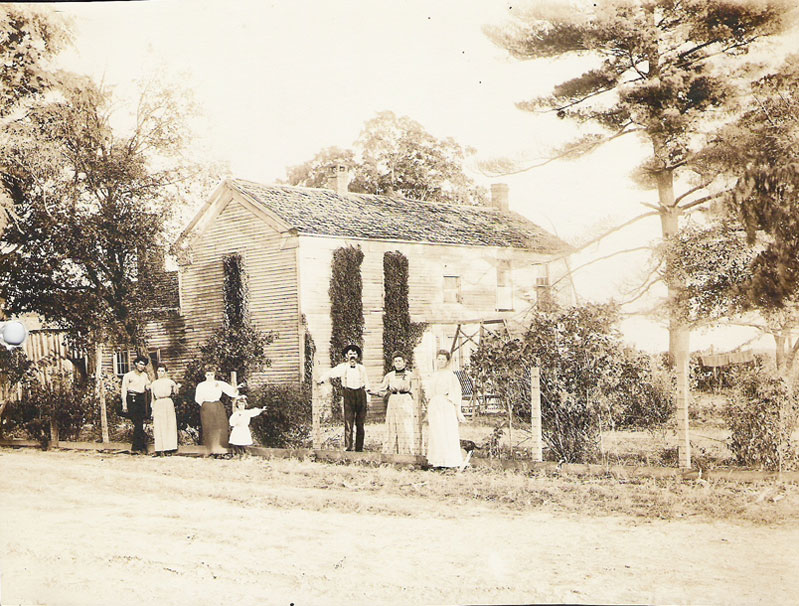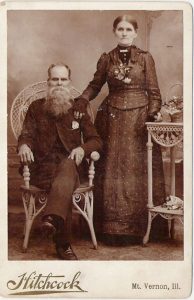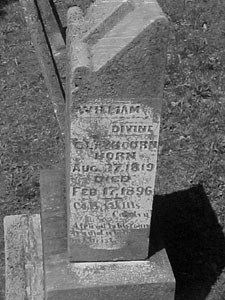-
Place of Birth
Knoxville, Tennessee
-
Place of Death
Jefferson Co., Ill.
-
Burial Place
Jordan Chapel Cemetery
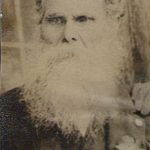
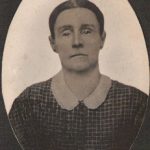
William Divine Claybourn was born on 27 August 1819 in Knoxville, Tennessee, and is the ancestor of the Claybourns originating in Southern Illinois. His progeny now number in the thousands and are spread far over the globe.
When William was about six years old, his father Ephraim moved the family – which then would have been four girls and three boys – to Liberty, Tennessee. There William received what education he had in a log cabin school. At the age of 20, on 4 September 1839, he married 18 year old Frances Alla Hawker (“Frankie”). Their son James H. wrote in a letter in 1906, “When father was married . . . he and his little wife (my mother) soon moved to Illinois where. . . his family was reared. They traveled in covered wagons and some of her people came with them.” 1[Verner M. Claybourn and Harriette Pinnell Threlkeld, The Claybourn Family (A-1 Business Service, 1959).
The Claybourn-Hawker “wagon train,” as it was called, crossed the Ohio River by ferry at Shawneetown, Illinois, and the group stayed there for a time. Shawneetown was a lively place with a land office serving a huge domain, a bank, a newspaper, and the first port within Illinois for rafts, flatboats, broadhorns, and the keelboats out of the east. It is possible the family stayed here in order to find permanent land through the land office.
The Shawneetown bank built in 1839 still stands and is currently owned by the Illinois Historic Preservation Agency. It was the first bank in Illinois and served as the Bank of Illinois. It is a Greek revival structure constructed of brick, with a limestone front facade, portico, and steps. Repeated floods – particularly a severe flood of the Ohio River in the spring of 1937 – caused the evacuation of the town to a bluff two miles away on higher ground. The bank and other remnants of the wild early village still remain on the old site, although it is no longer open to tours.
The Hawkers
Frankie’s family, including her parents Reuben and Nancy, made up the other half of the Claybourn-Hawker “wagon train.” The Hawkers were originally from Virginia but lived in DeKalb County, Tennessee, prior to the move to Illinois. The Hawkers and Claybourns were close families. Frankie and her siblings are listed below, although the brothers may have been half-siblings given the gap in birth years. Many of William and Frankie’s descendants bore the names of these siblings.
- Frances Hawker (“Frankie”), wife of William Divine Claybourn, was born on 23 September 1820 in Tennessee, and died on 25 July 1863, in Jefferson County, Illinois.
- Mary Polly Hawker was born on 28 August 1821 in Smith County, Tennessee. She married Fountain Garrison (1817-1855) in about 1841 and they had six children together.2Their six children: (1) Elizabeth Tennessee Garrison was born in about 1843 in Jefferson County, Illinois, and married William Davis (born in about 1835 in Ohio) on 3 May 1860 in Jefferson County. (2) John Crocket Garrison was born in February 1846 in Jefferson County and died there on 26 February 1923. He married Elizabeth T. Meek (1850-1920) on 17 November 1870 in Jefferson County. They had twin daughters Mary C. and Martha C. on 26 September 1871 in Jefferson County. The girls lived with their parents and never married. Mary C. died on 24 February 1924 in Union County, Illinois, and Martha C. died there on 7 August 1928. They are all buried together in Union Chapel Cemetery in Jefferson County. (3) America Fountain Garrison was born on 27 July 1848 in Jefferson County and died on 14 September 1902 in Morgan County, Illinois. She married George Washington Reed (1850-1934) on 10 August 1870 in Jefferson County. They are buried together in Chapin Cemetery in Morgan County. Per the 1900 census, she had given birth to nine children and seven were living. (4) Moses Pleasant Garrison was born on 3 December 1849 in Jefferson County. (5) Louisa Jane Garrison was born on 6 October 1852 in Jefferson County and died on 16 February 1934 in Parke County, Indiana. She married 1st on 1 September 1868 in Jefferson County to Thomas Bennett Short (1849-1898). Per the 1900 census, she had given birth to six children with all of them living. In about 1905 she married 2nd to widower James William Flowers (1849-1931) and lived with him in Lincoln County, Oklahoma, until his death there. She is buried in Wolf Creek Church Cemetery in Parke County as Jane Short Flowers. (6) Virginia Caroline Garrison was born on 23 December 1854 in Jefferson County and died on 8 January 1927 in Pottawatomie County, Oklahoma. She married William Thomas Osborn (1849-1921) on 20 September 1874 in Jefferson County. They are buried together in Brown Cemetery in Pottawatomie County. Per the 1900 census, she had given birth to six children with only two living, both of whom had moved with them to Oklahoma between 1887 and 1900. Mary died on 15 June 1878 in Jefferson County, Illinois, and they are both buried in there in Hopewell Cemetery.
- Reuben Bethel Hawker (“Bethel”) was born on 3 September 1833 in Tennessee.3Bethel Hawker was probably named for the Dr. Bethel of Liberty. It is not a coincidence that one of William Divine’s children was named John Bethel. During the American Civil War he enlisted in the Union Army with Company E of the 145th Illinois Volunteer Infantry Regiment on 25 May 1864 and served for three months and ten days per the 1890 veterans’ census. Bethel married first to Martha (c. 1840 – c. 1864) on 5 November 1857 in Jefferson County, Illinois, and they had three children.4Bethel and Martha’s children were: (1) Sarah E. Hawker was born in about 1859 in Jefferson County, Illinois. (2) John E. Hawker was born in about 1860 in Jefferson County, Illinois. (3) William Hawker was born in about 1863 in Illinois.] He married second to Sarah A. Hill (c. 1843 – c. 1890) on 5 November 1864 in Macon County, Illinois, and they had two children.[Bethel and Sarah’s children were: (1) James Hawker was born in about 1869 in Missouri. (2) Jane Belle Hawker was born on 24 January 1872 in Missouri and died on 18 July 1940 in Tulsa County, Oklahoma. She married Albert Franklin “Frank” Hunt (1864-1932) on 17 October 1888 in Dade County, Missouri. They are buried together in Clinton Oaks Cemetery in Tulsa County. He married third to Martha E. (1846-1907), widow of William N. Sawtell (1832-1892), on 12 April 1896 in Dade County, Missouri. Bethel died on 30 January 1903 in Dade County, Missouri, and is buried there in Rice Cemetery.
- Harrison Marion Hawker was born on 24 September 1835 in Tennessee. He married Susan Carpenter (1834-1907) on 6 March 1857 in Jefferson County, Illinois.5[They were married by Rev. William Maxey. Susan had come to Illinois in 1840 at the age of six years old, but eventually moved to the vicinity of Celest, Texas, near Greenville, in about 1900. Nevertheless, she is buried at Limestone beside her husband. She died on 20 September 1907.] Together Harrison and Susan had four children.6Their children were: (1) William M. Hawker was born on 8 April 1856 in Jefferson County, Illinois, and died there on 11 June 1924. William married a woman born in Illinois in about 1882 and they had three children born in Missouri. He was a widower living in Dade County, Missouri, by the 1900 census and is buried in Pleasant Hill Cemetery in Jefferson County with no marker. (2) Samuel L. Hawker was born on 31 October 1859 in Jefferson County and died on 15 December 1938 in Celeste, Texas. He married Louisa E. Wilson (1878-1902) on 22 February 1899 in Jefferson County. They had daughter later that year in Jefferson County then moved to Hunt County, Texas, where she died shortly after giving birth to another daughter who died the next year. Samuel, his wife, and infant daughter are all buried together in Celeste Cemetery in Hunt County. (3) Sarah J. Hawker was born on 27 August 1864 in Jefferson County. She married John Fletcher Tate (1866-1945) on 14 February 1900 in Jefferson County and they had no children. She died on 5 November 1911 in Celeste, Hunt County, Texas, is buried there in Celeste Cemetery. (4) Mary E. Hawker was born on 28 March 1868 in Jefferson County and died there in 1889. She married Eli Wesley Allen (1861-1934) on 28 April 1888 in Jefferson County. She had one daughter who was born and died in October 1889 and is buried in Pleasant Hill Cemetery in Jefferson County. Harrison died in Jefferson County on 8 April 1891. Harrison and Susan are buried together in Limestone Church and Cemetery (now Pleasant Hill) south of Dix in Jefferson County.7His gravestone bears the words, “A friend of his country, a believer in Christ,” a sentiment also carved on William Divine’s stone. They were married by Rev. William Maxey. Susan had come to Illinois in 1840 at the age of six years old, but eventually moved to the vicinity of Celest, Texas, near Greenville, in about 1900. She died on 20 September 1907.
The Old Goshen Road
Not long after their stay in Shawneetown, the Claybourn-Hawker wagon train headed northwest toward Jefferson County, Illinois, via the “Old Goshen Road.” This early road ran from Old Shawneetown to the Goshen Settlement, near Glen Carbon, Illinois. In the early 19th century this was the main east/west road in Illinois. The Goshen Road started as a natural route that was used by Native Americans and migrating animals. Therefore it was not a definite, marked out path. It was, rather, a collection of vague, parallel paths that crossed, shifting with the season and over the years.
Eventually the demand for salt solidified the road’s importance. “The builders of Goshen Road looked east, striving toward a place where they could obtain their necessity – salt,” wrote historian Barbara Burr Hubbs.8Egyptian Key, 1949. Salt was one of the dearest commodities that early settlers had and one of the most difficult to obtain. Settlers at Goshen at one time bought it eagerly for $9 a barrel. Hubbs explains further:
“In the east beyond the Ohio, men looked west, striving toward new homes and better living . . . The Goshen Road funneled new residents into Illinois Territory at such a rate, its citizens became ambitious to have a state. They came by horse-drawn wagons, by two-wheeled ox-carts; they rode horses and donkeys and ‘shank’s mares;’ they pushed wheelbarrows and carried their wealth on their backs. But they came and many stayed. Not all went the length of the road, but in 1818 when a census was taken to determine whether the Illinois population was sufficient for statehood, settlers lined the old route. It was a belt settlement from the Ohio at Shawneetown to the Mississippi at Alton . . . All across the state the generation whose fathers had traveled the Goshen Road blessed the men of Goshen who needed salt and built a road.”9Ibid.
John Reynolds, later Governor of Illinois, adds, “In the fall of 1808 a wagon road was laid off from Goshen settlement to the Ohio River salt works which in olden times was called The Goshen Road.” 10John Reynolds, The Pioneer History of Illinois, 2nd ed. (Chicago: Fergus Printing Company, 1887). The southern stretch of the road was permanently laid out in an interesting way to find a direct route without surveying. They led a mare a day’s journey away from her foal – then turned her loose. Rough blazes were cut on trees as the mare took the instinctive straightest course back to her foal.11Claybourn, The Claybourn Family.
Early Jefferson County
Famed philosopher Baker Brownell described early Jefferson County this way:
“This Southern Illinois country was planned by Nature more to delight rivermen, hunters and fisherman, and folks willing to forego good soil for a house on a hill, than to facilitate. . . the acquisition of wealth. . . These deep-eyed, thin-lipped people were the first to come of those who still remain. . . [They]. . . were rural and mountain folk [who]. . . hacked their way into the magnificent hardwood forests, split rails for fences, rolled the great walnut, oak, elm, beech, sycamore, poplar, locust logs together for burning, piled the brush, and grubbed out farms in the uncertain soil.”
Baker Brownell, The Other Illinois (New York: Duell, Sloan and Pearce, 1958).
Brownell notes the soil because the central plateau upon which the county sits is made of a tough, recalcitrant clay pan, so hard to break that the settlers could not use their wooden plows. Brownell goes on, “Spring is incandescent here; it glows with strange, soft fire. The autumns are golden and still; each tree in its own way a transfiguration. There are more kinds of trees in these few counties than in all of Europe.” 12Ibid.
Jefferson County was settled by American stock of several generations. They were not of foreign birth. A hundred years later, it was still the same. By the mid-20th century in Mt. Vernon there were not more than two or three families of Italian derivation and a family of several Greek brothers.13Claybourn, The Claybourn Family. The rest were descendants of these early settlers, predominantly Methodists and Baptists from Kentucky and Tennessee.
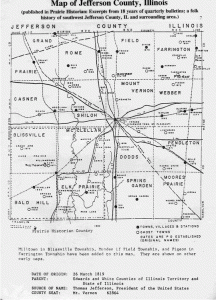
The first settler in Jefferson County was Andrew Moore, who left Goshen in 1810 and traveled east on the Goshen Trail. He eventually arrived at a place about twelve miles southeast of present Mt. Vernon and built a cabin there. This would later be known as Moore’s Prairie, as noted on the map at left. Moore’s cabin was the first Caucasian settlement in Jefferson County, and Moore and his family lived there for several years. He and his son were killed by Native Americans, it is presumed, at their overnight camp on the Big Muddy River as they were returning from a mill. His skull was found some years later by hunters, identified, and buried near the cabin. When he did not return, his wife and the small children tried to find him, learned at the mill in Franklin County that he had started for home, and, after not being able to locate his body, abandoned the lonely cabin and moved to the Saline salt works.
The Caseys came next in 1816. Zadok Casey, a prominent Methodist member of Congress from Illinois (1833-1841), began his life in what became Jefferson County with a camp fire beside a massive log in (now) Shiloh Township. When he came, he brought his wife and child on one horse. He walked beside them with his rifle on his shoulder. He had no one to help him build a pole cabin. Later his substantial home, Elm Hill, was built west of Mt. Vernon village on the site of what is now Zadok Casey Middle School.
The Maxeys, antecedents of Harriett Maxey Claybourn (James Harrison Claybourn’s second wife), were among the next group of settlers to come. A party of 21 people led by William Maxey, age 48, left Gallatin, Tennessee, on 20 April 1818 and crossed the Ohio River at Cave-in-Rock, and followed the Old Goshen Trail until they reached the Moore cabin, four miles southeast of the present town of Belle Rive.
David Crenshaw and Carter Wilkey had moved into Moore’s deserted cabin and farmed in 1816. They were related by marriage to the Maxeys and were there when the Maxey party arrived. They spent the first summer in Moore’s Prarie but were persuaded by Zadok Casey to move up near his settlement that fall, and William Maxey settled on land adjoining Casey to the east. This was about three miles northwest of what is now Mt. Vernon. William Maxey acquired the land from the government in 1825, and it remained in possession of the Maxey family for four generations and over 100 years.
Early Mt. Vernon
Illinois became a state and Jefferson County was organized in 1818, with Zadok Casey serving as was one of the Commissioners. William Casey, whose home was where the post office later stood, was the nephew of Zadok Casey. William donated 20 acres of his land to be laid off in lots and sold for the purpose of paying for public buildings in Jefferson County. The town leaders advertised this sale in the Illinois Emigrant in Shawneetown and sent handbills over the county. There were only six families in the Mt. Vernon area at that time, but about 100 persons showed up to buy lots around a little clearing in the woods, staked out with mulberry posts, which was to be the public square surrounding the courthouse.
Bennett Maxey, Harriett Maxey’s grandfather’s brother, bought the first lot for $41. Burchett Maxey, Harriett’s grandfather, built a log house one half block from the present square on the west side of north Tenth Street which served as a tavern as well. He got the contract to build the first jail of hand “hughed” black walnut logs for $320. In 1823 he bought the lot on the southwest corner of 10th and Main, where the First National Bank (formerly Third National) later stood and there built the first home on the public square in Mt. Vernon.
The first courthouse was an 18 x 20 foot log building with one door and one window and no fireplace because one was not stipulated in the contract. It cost $85. There it stood in the midst of a great forest, but it was the beginning.
Except for the death of Andrew Moore, these pioneers of Jefferson County were not bothered by the Native Americans, although in 1818-19 a group of Delaware Indians passed through the county on their way to western reservations. A party of about 600 camped on Horse Creek for several months in Farrington Township, the area where Harriette Threkeld’s mother was born some sixty years later.
Mt. Vernon was officially incorporated on 10 February 1837 with a population of 150. It had 6 stores, three taverns and an inn. On the present North 11th Street, one half block from Main Street and on the west side of the street (just back of the present City Hall), the first church for Mt. Vernon was built. Its original sandstone foundations remained until it was demolished in the 1930’s. A small church was built for the Methodists in 1834 and enlarged in 1839. The building retained its original architectural lines and had a window in the shape of a cross in the west end. Wrought iron nails were used. Governor Casey presented the church with a bell in 1840 which is believed to be the one used by the United Brethren Church in later days.
The principal business in early Mt. Vernon was the gathering of deer skins which were shaved and sent to the market in St. Louis. Mt. Vernon did not become a wagon road center until 1844. In 1830 the population of Jefferson County was 2,555, but by 1840 when the Claybourns came, it had grown to 5,762. It was no longer the wilderness the Maxeys found. In 1850 Mt. Vernon had a population of 300, but more than doubled to 707 by 1860, the beginning of the Civil War. By 1900, Mt. Vernon had 5,216 people and was recovering from the destruction of a tornado that struck in 1888.
Historian William Perrin says that William D. Claybourn came in “about 1840” from Tennessee and settled in Field Township, one of the earliest settlers in that area.14William Perrin, History of Jefferson County (Chicago, 1883). According to family tradition, Catherine, the oldest child of William Divine and Frankie, was probably born in Tennessee before they left. The next child, Sarah, was born at Shawneetown where they stayed a while, probably to find from the land office where they might settle. James H. Claybourn was the first of the family born in Jefferson County, Illinois, on 27 April 1843.
William’s land in Field Township totaled one hundred and sixty acres.[In the Jefferson County Courthouse, Book 81, Page 270, is a copy of the Land Patent of William D.’s farm. In the Index to Deeds in the Circuit Clerk’s office under Grantors S to Z, from 1 Jan. 1828, to 31 Dec. 1947, the Grantor is the United States Government to William D. Claybourn. The Patent states that William, in accordance with the Land Act of 24 April 1820, had paid in full to the land office at Shawneetown for one hundred and sixty acres, described thus: “The east half of the Northwest Quarter and the south half of the Northeast Quarter of Section 17, Township 1 South Range 3 East of the third Principal Meridian in Fields Township, Jefferson County, Illinois.” It is signed by Franklin Pierce, President of the United States, and the instrument is dated 1 March 1855.] The first cabin on the land was placed on high ground, near the creek. The barn was placed a little lower down a slope and near a spring. In October of 1959 Eula Claybourn Osborn, who lived on part of the original homestead, took Harriette Threkeld and Verner Claybourn (by a wagon hitched to a tractor) to the site of the original cabin. Eula knew of its exact location because she had helped her father fill in an old well which had been left long after the cabin was moved. Harriette writes:
If one stands on the road near the railroad tracks and looks north across the bottoms to the wooded bluff, he is looking toward the site. The farm stretches for a mile and a half along the Dix to Divide Road and was cut by the Chicago and Eastern Illinois Railroad when it was built. The township was to have been called Claybourn instead of Field, but there was another township in the state by that name. Eula Osborn said she thought the name Texico was made up from initials of different families living in that area. All of the original farm is on the north side of the road. The village is built on the original farm. . . The cabin had two rooms and a loft above where later the boys slept.
Later a road was built and the cabin was moved to it. The children attended Beehive School (later called Upper Hawkins). According to Perrin, the first school house built in Field Township was built on Big Muddy on the McCrary farm and was a log cabin that was sixteen feet square with slab seats, puncheon floor and an old time fireplace.15Perrin, History of Jefferson County. Undoubtedly it was there that James Harrison and the other children received their education. When the family became quite large the two oldest children would carry a bushel basket of lunch between them for the Claybourn kids to eat.
Civil War Service
Like many men during this era, William served in the Civil War with his children and fought against some southern relatives. He served in Company H of the First Illinois Cavalry Regiment with his oldest son, James H. Claybourn. The group, also known as Noleman’s Cavalry after its captain Robert D. Noleman, was organized at Centralia. William joined the company on 10 July 1861 at Cairo, Illinois, and was mustered in seven days later on 7 July 1861. Although his term of service lasted only for about one year, he and the company saw a tremendous amount of action and fought valiantly.
After rendezvousing at Cairo the group was transferred to Bird’s Point, Missouri, and scouted throughout southeastern Missouri and western Kentucky from the fall of 1861 through early 1862. In October 1861 Lieutenant Samuel P. Tufts was scouting with 26 men from Company H when they encountered 100 mounted Confederates. Despite being outnumbered they engaged the enemy. Lieut. Tufts wrote in his official account of the events, “My men deserve great praise for the coolness, bravery, and implicit obedience to my commands exhibited throughout the engagement, several of whom stood firmly, receiving the fire of the enemy, with by one shot held in reserve, and awaiting my orders.” 16Robert N. Scott and Henry M. Lazelle, The War Of The Rebellion: A Compilation Of The Official Records Of The Union And Confederate Armies, Series I Volume XXII In Two Parts (Washington: Government Printing Office, 1888). This account is also available online and reads as follows: CAMP LYIN, BIRD’S POINT, MO., October 15, 1861.
SIR: Pursuant to orders, I proceeded, with 26 men of my company (Captain Noleman’s Centralia Cavalry), on a scout out upon the Rushes Ridge road, taking a direction towards the Beckwith farm. When mounted rebels, about 100 strong, supposed to be Mississippi or Tennessee Mounted Rifles, armed with breech-loading rifles and revolvers. My advance guard, after giving the usual signal (the enemy continuing to advance), discharged their carbines and fell back upon the column. We were moving down the road through a clearing, the enemy being in the timber. I immediately ordered the advance, and advanced into the open timber, taking a position within 180 yards of where the enemy were forming, and engaged the enemy, who were partly concealed by dense underbrush and heavy timer. The enemy poured a rapid fire upon our position until we were nearly surrounded and our ammunition almost exhausted. We then retired, the enemy following close upon our rear, and engaged my rear guard for about 1 1/2 miles, when the enemy retreated. We brought our wounded men and horses off of the field, with the exception of Corporal H. H. Fletcher, his horse, equipments, and arms. Corporal Fletcher was shot in the temple, some distance in awards discovered still living by Dr. Baker, residing in the vicinity, and by him removed to his residence. Private Louis Krenyhoff received a flesh wound in the arm, the ball passing across the chest and lodging inside the shirt. Several others received slight scotches from shattered balls. The horses of Privates J. Copeland, S. T. Maxy, W. Hutter, and E. T. Amadan were mortally wounded and left on the road. Seven other horses were wounded more or less seriously. The enemy on their retreat stripped Corporal Fletcher of his arms and spurs. Two others lost their carbines. The loss of the enemy, as near as could be ascertained, was from 6 to 10 men either killed or seriously wounded, including the officer in command. Of their horses one was left dead upon the field and others taken off evidently wounded. My men deserve great praise for the coolness, bravery, and implicit obedience to my commands exhibited throughout the engagement, several of whom stood firmly, receiving the fire of the enemy, with by one shot held in reserve, and awaiting my orders. They retired in as good order as circumstances would permit, the rear guard contesting their ground nobly.
Respectfully, &c.,
S. P. TUFTS,
Lieutenant, Commanding Expedition.
Colonel W. H. L. WALLACE, Commanding
On 7 November 1861 they fought in the Battle of Belmont in Mississippi County, Missouri. It was the first combat test for Brigadier General Ulysses S. Grant, the future Union Army general in chief and eventual U.S. president. On 2 March 1862, the group, joined by then-Colonel James D. Morgan, led the pursuit of Confederate Brigadier General M. Jeff Thompson in southeastern Missouri. They met stiff resistance and were unsuccessful in capturing Thompson, but did capture artillery. Col. Morgan praised the group’s perseverance. According to an old photostat listing promoting the company, Gen. Thompson later recalled, “The cavalry are a perfect set of daredevils, all officers wearing feathers on their hats.”17“Centralia Cavalry Company,” Tennessee State Library & Archives, accessed 26 November 2013.
A photostat includes a sketch of the cavalry lined up in front of their tents. At the bottom under “History,” it reads, “Organized at Centralia, Illinois, and mustered into service of the United States on the 14th of June, 1861 (for the period of one year). Bushwacked and jayhawked among the swamps of southeast Missouri for 12 months, capturing 167 prisoners, 209 horses and mules, shotguns, rifles, and toothpicks innumerable; cramping nothing larger than a steamboat or smaller than a grindstone.”
From February to April 1862 the company joined Brigadier General John Pope in the Union effort to take New Madrid, or Kentucky Bend, on the Mississippi River. Their engagements included the Battle of Island Number Ten and the Confederate surrender after that battle at Tiptonville, Tennessee. After the fall of New Madrid the company proceeded down the Mississippi River, and in June 1862 they were the first U.S. troops to enter the city of Memphis. In July 1862 they were ordered to St. Louis to be mustered out of service. William was mustered out there as a Corporal on 5 July 1862.
After his twelve month stint was over, William did not return to fight in the war. This was not uncommon and, after all, he had a large family at home which needed care. In 1857 the oldest daughter Catherine (called “Kit”) married Joe Boggs, who was killed in the Civil War. The other children were all married after the war. Two of William Divine’s sons, James H. Claybourn and William Pratt Claybourn, served out the remainder of the war in Company H of the 80th Illinois Infantry. The third son, John Bethel Claybourn, served with the 136th Illinois Volunteer Infantry, enlisting when he was 17 in 1863. Still at home were the younger children, four boys and two girls.
The Civil War divided countless families across the country, but William’s two brothers in the South remained loyal to the Union throughout the war. Nevertheless, some of John B. Claiborne‘s sons (William’s nephews) were conscripted and forced into the Confederate army. One of those sons, John H. Claiborne, was captured by Union forces and sent north. In 1919 William’s son James wrote, “John H. . . was captured and brought north where he took the oath of allegiance and was released from prison and came to our house and stayed until the war was over.”
After the war, in 1866, William’s brother John B. Claiborne and his wife Perlina lived in Jefferson County for a time to live with William. Perhaps John B.’s move to Illinois was motivated in part by the war’s desolation in Arkansas. It may have seemed like a chance to start over. Evidently, though, the stay in Illinois did not in fact turn out to be a happy one and John B. moved back after some time. Harriette Threlkeld believed the unhappiness stemmed from divisive disagreements over the Civil War.
The Big House
After William Divine’s service in the war he returned home and began building what would be known as “The Big House.” But on 25 July 1863, just before work was completed, William’s wife Frankie gave birth to an unnamed infant. Sadly she did not survive the labor, and the child died a couple weeks later.
By the time the house was completed it had two stories with two large rooms above and two below. It faced west and was left standing in a field in later years after the road from Dix to Divide was changed and passed along the south boundary of William’s original farm, just as it does today. The northwest room was the sitting room and had a fireplace in the east end. There was a fairly wide hall with a stairway to the second floor, and a large bedroom on the south. A one-story part of the house ran straight back along the north side and contained three rooms, including the dining room and kitchen. Most people entered by the north door from the road running along the north side at that time.
The house was built of oak clapboard and cut, most likely, from the farm. The windows were symmetrically placed, and there was an attractive front door with small panes of glass on either side. The kitchen had a large fireplace and wide-board hardwood floors. A porch ran along the south side of the one story part. There were many trees in the yard.
Norah Claybourn Hunsinger, a grandchild, recalled attending a surprise birthday celebration for William Divine when she was a young girl at which family and friends gathered. They celebrated outdoors and spread tables in the yard under trees. “Aunt Sally” baked a tiered birthday cake, using a tin cup to bake the last small layer. Norah said she recalled her grandfather very well on that day. He was touched and cried at the tribute to him. This may have been his 65th birthday for in that year, 1884, Sally moved to Kansas. They moved the family organ out into the yard and the crowd sang “God Be With You Till We Meet Again” as they parted. “The Big House” remained standing until the 1930s.
Second Marriage to Elizabeth (“Lizzie”) Maxey
When Frankie died at age 43, she left an infant who would die two weeks later. Also at home were twelve year old Ephraim Smith, the eleven year old twins (Joseph Monroe and Reuben Cicero), seven year old Candace, five year old Vone, and three year old Cashus. A year and a half later, on 15 February 1865, William Divine married Ms. Elizabeth Jennings Starnes Maxey, whose brother Sam married war-widowed Catherine (“Aunt Kit”), William Divine’s oldest child.
Elizabeth (called “Lizzie”) was born on 27 January 1827 to Lucy S. Ford and Francis Starnes (sometimes spelled “Sternes”) of Virginia. Prior to marrying W.D. Claybourn, Lizzie was married to William Henry Maxey, who died on 3 March 1859.18William Henry Maxey was born on 18 July 1823 in Jefferson County, Illinois. His father was Bennett Maxey. William Henry married Elizabeth on 6 February 1845 according to the family Bible. He appears to have spent all of his life in Jefferson County, Illinois. Lizzie and W.H. Maxey had eight children of their own prior to W.H. Maxey’s death. The eight children were Bennett Nelson Maxey,19Bennet Nelson Maxey was born on 23 January 1846 and died shortly thereafter on 2 May 1846. Sarah Jane Maxey,20Sarah Jane Maxey was born on 26 February 1847 and was baptized on 4 September 1847. Sarah died at the age of four on 14 August 1851. Melissa Virginia Maxey,21Melissa Maxey was born on 29 December 1848 and was baptized on 3 July 1849. She married James R. Fields on 22 August 1867 and they had a child named William A. Fields on 17 October 1868. Melissa died in 1915. George Washington Maxey,22George Washington Maxey was born on 30 October 1850 and was baptized by Rev. James A. Robinson on 27 May 1851. He died on 28 January 1886. All of the foregoing is based upon information in the “Claybourn Bible” of 1872. Laura Luella Maxey,23Laura Maxey was born in July of 1852 and was baptized at Pleasant Hill Campground on 3 October 1852, according to information found in the “Claybourn Bible” of 1872. She married William M. Myers on 14 January 1869 and lived at Texico. Allen Robinson Maxey,24Allen Maxey was born on 19 February 1854 and was baptized on 15 June 1854, according to information found in the “Claybourn Bible” (1872). Mary Lucinda Maxey,25Mary Maxey was born on 8 September 1856 and was baptized on 14 February 1857. She married Hiram Maxfield on 7 June 1874 and lived in Centralia, Illinois. and William Henry Maxey Jr.26William Henry Maxey Jr. was born on 8 September 1859 and was baptized in 1861 by Rev. Robbins at Pleasant Rose. He married first to Lucinda E. Harvey (1861-1897) on 8 January 1880 in Jefferson County. They then moved to Kinmundy, Illinois, where she died. William married second to Julia Olive Williams (1869-1937) on 11 August 1898 in Marion County, Illinois. William died on 24 December 1919 in Kinmundy. He and both wives are buried in Evergreen cemetery in Marion County, Illinois.
The Big House was barely big enough for the parents and eleven children (William’s children still at home plus some of Lizzie’s from her prior marriage). Eventually space would get even tighter when William and Lizzie had children of their own. About this time there were eighteen people to sit down to meals three times a day. The three boys who were away in the war married soon after their return.
Discovery of Artifacts
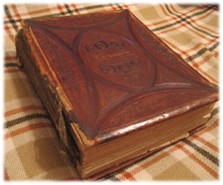
In 2009, Joshua A. Claybourn was contacted by Barbara Wentz, a genealogist who haunts flea markets. In a Kutztown, Penn. flea market she discovered three incredible artifacts relating to William Divine and Lizzie’s family. The first is a Family Bible printed in 1872 with W.D. Claybourn engraved into the leather cover and E.J. Claybourn engraved on the back cover. Inside were pages detailing various family records such as the births, deaths and marriages of William and Lizzie’s family, including Lizzie’s children from her first marriage. These separate family record pages appear to have been older than the Bible itself, and may have been transferred from an even older Bible. Either way, they have provided a valuable opportunity to affirm the dates of certain births, deaths and marriages included in these biographies.
The second artifact is a Norfleet family photo album. William and Lizzie’s daughter Lucy Belle married into the Norfleet family, and this album contains numerous photographs of Lucy’s family, as well as some of William and other Claybourn relatives. The third artifact is a wedding album of James Stitt and Dorothy Jewett. Dorothy was a granddaughter of William Lizzy and a daughter of Lucy Belle. Apparently Dorothy and/or her husband moved to a nursing home and parted with most household items. Amazingly, the wedding album had been placed in the trash by house cleaners before being salvaged by antique dealers. All of these artifacts have been invaluable to CGS efforts.
Twilight Years and Death
Smallness of stature was a Claybourn characteristic, and William was a small man who in adult life always wore a long, full beard. In later years he suffered from a cancer on his lip which was the ultimate cause of his death. His son James accompanied him to Chicago at one time for treatment. All of the family loved to sing, and his granddaughter, Eula Osborn, says that when William was old and sick from the cancer and could not work, he sat on the porch and sang, and one could hear from him clear across the fields.
William died on 17 February 1896, at the age of 77. Norah Hunsinger remembers accompanying her parents and sister Inis to the funeral which was held in the frame Methodist Church in Dix. A small red brick Methodist Church, which is still standing there, was the Methodist Episcopal Church, South. According to his obituary Rev. Isaac Bundy conducted the services under the auspices of the Grand Army of the Republic.27The Daily Register, Tuesday, 18 February 1896. He was familiarly called “Uncle Billy” and was “at the time of his death one of the oldest citizens of the county where he had resided for more than half a century.” Perrin lists William’s occupation as farming and stockraising, and states that he was a Republican and a member of the Methodist Episcopal Church.28William Perrin, History of Jefferson County (Chicago, 1883).
William is buried at Jordan Chapel Cemetery beside his first wife, Frances Hawker Claybourn. His gravestone bears the words, “A friend of his country, a believer in Christ,” a sentiment also carved on his brother-in-law’s gravestone. About thirty six Claybourns and connections are buried at Jordan Chapel.
Lizzie outlived William, and when the big house was sold, she lived in a small house closer to Texico village. During this time she wrote an inscription in the family Bible indicating she had become lonely missing Bill (presumably William Divine), and another about how much she missed Lucy Belle. Lizzie died on 11 December 1911 at the age of 83 and was buried at Pleasant Grove beside her first husband.
And as “he bent his way,” so did his way bend him. God-fearing and with dignity William labored and carved his place in the wilderness with his hands. He loved his country and fought for it. When his body failed him in all else, he sang. And that, you descendants of William Divine Claybourn, is your heritage: simple, ungarnished, pure and true Americanism.
Descendants
The descendants of William Divine Claybourn now number in the hundreds and are spread far over the country. Of his seventeen children, thirteen grew to maturity. The fourteen children of William and Frances Alla are listed below (click names for separate biographical sketches).
- Mary Catherine Claybourn (17 August 1839 – 13 February 1910)
- Sarah Jane Claybourn (27 July 1841 – 27 January 1913)
- James Harrison Claybourn (27 April 1843 – 8 April 1920)
- William Pratt Claybourn (25 December 1844 – 11 February 1900)
- John Bethel Claybourn (24 December 1846 – 19 March 1937)
- Harriett Claybourn (5 March 1849 – 27 September 1852)
- Ephraim Smith Claybourn (8 February 1851 – 1909)
- Elizabeth Claybourn (born and died on 29 January 1852)
- Joseph Monroe Claybourn – (31 May 1854 – August 1927)
- Reuben Cicero Claybourn (31 May 1854 – 13 March 1921)
- Candace Frances Frost Claybourn (29 August 1856 – c. 1941)
- Livona Cordelia Claybourn (20 April 1858 – 13 January 1930)
- Cashus M. Columbus Theodore Claybourn (13 April 1860 – 13 December 1936)
- Unnamed infant (25 July 1863 – 7 August 1863), preceded in death by its mother two weeks earlier.
The three children of William and Elizabeth are as follows:
- Charles Frank Claybourn (15 November 1865 – 21 July 1939)
- Lucy Belle Claybourn (20 May 1867 – 21 April 1949)
- Minnesota Claybourn (2 October 1869 – 17 December 1869)
Footnotes
- 1[Verner M. Claybourn and Harriette Pinnell Threlkeld, The Claybourn Family (A-1 Business Service, 1959).
- 2Their six children: (1) Elizabeth Tennessee Garrison was born in about 1843 in Jefferson County, Illinois, and married William Davis (born in about 1835 in Ohio) on 3 May 1860 in Jefferson County. (2) John Crocket Garrison was born in February 1846 in Jefferson County and died there on 26 February 1923. He married Elizabeth T. Meek (1850-1920) on 17 November 1870 in Jefferson County. They had twin daughters Mary C. and Martha C. on 26 September 1871 in Jefferson County. The girls lived with their parents and never married. Mary C. died on 24 February 1924 in Union County, Illinois, and Martha C. died there on 7 August 1928. They are all buried together in Union Chapel Cemetery in Jefferson County. (3) America Fountain Garrison was born on 27 July 1848 in Jefferson County and died on 14 September 1902 in Morgan County, Illinois. She married George Washington Reed (1850-1934) on 10 August 1870 in Jefferson County. They are buried together in Chapin Cemetery in Morgan County. Per the 1900 census, she had given birth to nine children and seven were living. (4) Moses Pleasant Garrison was born on 3 December 1849 in Jefferson County. (5) Louisa Jane Garrison was born on 6 October 1852 in Jefferson County and died on 16 February 1934 in Parke County, Indiana. She married 1st on 1 September 1868 in Jefferson County to Thomas Bennett Short (1849-1898). Per the 1900 census, she had given birth to six children with all of them living. In about 1905 she married 2nd to widower James William Flowers (1849-1931) and lived with him in Lincoln County, Oklahoma, until his death there. She is buried in Wolf Creek Church Cemetery in Parke County as Jane Short Flowers. (6) Virginia Caroline Garrison was born on 23 December 1854 in Jefferson County and died on 8 January 1927 in Pottawatomie County, Oklahoma. She married William Thomas Osborn (1849-1921) on 20 September 1874 in Jefferson County. They are buried together in Brown Cemetery in Pottawatomie County. Per the 1900 census, she had given birth to six children with only two living, both of whom had moved with them to Oklahoma between 1887 and 1900.
- 3Bethel Hawker was probably named for the Dr. Bethel of Liberty. It is not a coincidence that one of William Divine’s children was named John Bethel.
- 4Bethel and Martha’s children were: (1) Sarah E. Hawker was born in about 1859 in Jefferson County, Illinois. (2) John E. Hawker was born in about 1860 in Jefferson County, Illinois. (3) William Hawker was born in about 1863 in Illinois.] He married second to Sarah A. Hill (c. 1843 – c. 1890) on 5 November 1864 in Macon County, Illinois, and they had two children.[Bethel and Sarah’s children were: (1) James Hawker was born in about 1869 in Missouri. (2) Jane Belle Hawker was born on 24 January 1872 in Missouri and died on 18 July 1940 in Tulsa County, Oklahoma. She married Albert Franklin “Frank” Hunt (1864-1932) on 17 October 1888 in Dade County, Missouri. They are buried together in Clinton Oaks Cemetery in Tulsa County.
- 5[They were married by Rev. William Maxey. Susan had come to Illinois in 1840 at the age of six years old, but eventually moved to the vicinity of Celest, Texas, near Greenville, in about 1900. Nevertheless, she is buried at Limestone beside her husband. She died on 20 September 1907.]
- 6Their children were: (1) William M. Hawker was born on 8 April 1856 in Jefferson County, Illinois, and died there on 11 June 1924. William married a woman born in Illinois in about 1882 and they had three children born in Missouri. He was a widower living in Dade County, Missouri, by the 1900 census and is buried in Pleasant Hill Cemetery in Jefferson County with no marker. (2) Samuel L. Hawker was born on 31 October 1859 in Jefferson County and died on 15 December 1938 in Celeste, Texas. He married Louisa E. Wilson (1878-1902) on 22 February 1899 in Jefferson County. They had daughter later that year in Jefferson County then moved to Hunt County, Texas, where she died shortly after giving birth to another daughter who died the next year. Samuel, his wife, and infant daughter are all buried together in Celeste Cemetery in Hunt County. (3) Sarah J. Hawker was born on 27 August 1864 in Jefferson County. She married John Fletcher Tate (1866-1945) on 14 February 1900 in Jefferson County and they had no children. She died on 5 November 1911 in Celeste, Hunt County, Texas, is buried there in Celeste Cemetery. (4) Mary E. Hawker was born on 28 March 1868 in Jefferson County and died there in 1889. She married Eli Wesley Allen (1861-1934) on 28 April 1888 in Jefferson County. She had one daughter who was born and died in October 1889 and is buried in Pleasant Hill Cemetery in Jefferson County.
- 7His gravestone bears the words, “A friend of his country, a believer in Christ,” a sentiment also carved on William Divine’s stone. They were married by Rev. William Maxey. Susan had come to Illinois in 1840 at the age of six years old, but eventually moved to the vicinity of Celest, Texas, near Greenville, in about 1900. She died on 20 September 1907.
- 8Egyptian Key, 1949.
- 9Ibid.
- 10John Reynolds, The Pioneer History of Illinois, 2nd ed. (Chicago: Fergus Printing Company, 1887).
- 11Claybourn, The Claybourn Family.
- 12Ibid.
- 13Claybourn, The Claybourn Family.
- 14William Perrin, History of Jefferson County (Chicago, 1883).
- 15Perrin, History of Jefferson County.
- 16Robert N. Scott and Henry M. Lazelle, The War Of The Rebellion: A Compilation Of The Official Records Of The Union And Confederate Armies, Series I Volume XXII In Two Parts (Washington: Government Printing Office, 1888). This account is also available online and reads as follows: CAMP LYIN, BIRD’S POINT, MO., October 15, 1861.
SIR: Pursuant to orders, I proceeded, with 26 men of my company (Captain Noleman’s Centralia Cavalry), on a scout out upon the Rushes Ridge road, taking a direction towards the Beckwith farm. When mounted rebels, about 100 strong, supposed to be Mississippi or Tennessee Mounted Rifles, armed with breech-loading rifles and revolvers. My advance guard, after giving the usual signal (the enemy continuing to advance), discharged their carbines and fell back upon the column. We were moving down the road through a clearing, the enemy being in the timber. I immediately ordered the advance, and advanced into the open timber, taking a position within 180 yards of where the enemy were forming, and engaged the enemy, who were partly concealed by dense underbrush and heavy timer. The enemy poured a rapid fire upon our position until we were nearly surrounded and our ammunition almost exhausted. We then retired, the enemy following close upon our rear, and engaged my rear guard for about 1 1/2 miles, when the enemy retreated. We brought our wounded men and horses off of the field, with the exception of Corporal H. H. Fletcher, his horse, equipments, and arms. Corporal Fletcher was shot in the temple, some distance in awards discovered still living by Dr. Baker, residing in the vicinity, and by him removed to his residence. Private Louis Krenyhoff received a flesh wound in the arm, the ball passing across the chest and lodging inside the shirt. Several others received slight scotches from shattered balls. The horses of Privates J. Copeland, S. T. Maxy, W. Hutter, and E. T. Amadan were mortally wounded and left on the road. Seven other horses were wounded more or less seriously. The enemy on their retreat stripped Corporal Fletcher of his arms and spurs. Two others lost their carbines. The loss of the enemy, as near as could be ascertained, was from 6 to 10 men either killed or seriously wounded, including the officer in command. Of their horses one was left dead upon the field and others taken off evidently wounded. My men deserve great praise for the coolness, bravery, and implicit obedience to my commands exhibited throughout the engagement, several of whom stood firmly, receiving the fire of the enemy, with by one shot held in reserve, and awaiting my orders. They retired in as good order as circumstances would permit, the rear guard contesting their ground nobly.
Respectfully, &c.,
S. P. TUFTS,
Lieutenant, Commanding Expedition.
Colonel W. H. L. WALLACE, Commanding - 17“Centralia Cavalry Company,” Tennessee State Library & Archives, accessed 26 November 2013.
- 18William Henry Maxey was born on 18 July 1823 in Jefferson County, Illinois. His father was Bennett Maxey. William Henry married Elizabeth on 6 February 1845 according to the family Bible. He appears to have spent all of his life in Jefferson County, Illinois.
- 19Bennet Nelson Maxey was born on 23 January 1846 and died shortly thereafter on 2 May 1846.
- 20Sarah Jane Maxey was born on 26 February 1847 and was baptized on 4 September 1847. Sarah died at the age of four on 14 August 1851.
- 21Melissa Maxey was born on 29 December 1848 and was baptized on 3 July 1849. She married James R. Fields on 22 August 1867 and they had a child named William A. Fields on 17 October 1868. Melissa died in 1915.
- 22George Washington Maxey was born on 30 October 1850 and was baptized by Rev. James A. Robinson on 27 May 1851. He died on 28 January 1886. All of the foregoing is based upon information in the “Claybourn Bible” of 1872.
- 23Laura Maxey was born in July of 1852 and was baptized at Pleasant Hill Campground on 3 October 1852, according to information found in the “Claybourn Bible” of 1872. She married William M. Myers on 14 January 1869 and lived at Texico.
- 24Allen Maxey was born on 19 February 1854 and was baptized on 15 June 1854, according to information found in the “Claybourn Bible” (1872).
- 25Mary Maxey was born on 8 September 1856 and was baptized on 14 February 1857. She married Hiram Maxfield on 7 June 1874 and lived in Centralia, Illinois.
- 26William Henry Maxey Jr. was born on 8 September 1859 and was baptized in 1861 by Rev. Robbins at Pleasant Rose. He married first to Lucinda E. Harvey (1861-1897) on 8 January 1880 in Jefferson County. They then moved to Kinmundy, Illinois, where she died. William married second to Julia Olive Williams (1869-1937) on 11 August 1898 in Marion County, Illinois. William died on 24 December 1919 in Kinmundy. He and both wives are buried in Evergreen cemetery in Marion County, Illinois.
- 27The Daily Register, Tuesday, 18 February 1896.
- 28William Perrin, History of Jefferson County (Chicago, 1883).

